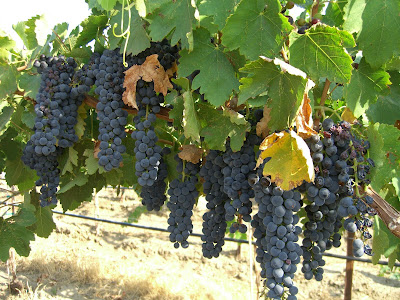
Sarah and Sarah watch the yeast come alive before innoculation.

The yeasts are set free into their playground.
Brent and Sarah Goedhart are my invaluable mentors, and have a well oiled operation producing a few hundred cases of their own Red Mountain Syrah. They have generously taken a few minutes from their busy crush schedules to assist our small science project. Day two in the life of a wine seems an important one. B+S measured the sugar content of our must on the morning of the second day and found that the Brix (sugar) was 26.3, which could result in a very high alcohol wine, and so we added 1.2gallons of water to aim for a final alcohol content somewhere around 14.1. The must is now up to 13.9 gallons. The SO2 that was added yesterday has mostly reacted with other compounds in the must and free SO2 levels (sulfur) are low. Fermentation is then restarted with a known yeast. The yeast comes in a powder and is mixed with warm water and grape juice to 'wake them up' and its amazing to see the yeast start to react and grow within about 10 minutes of hydration and the addition of sugar. The enlivened yeast mixture immediately takes on that pungent and distinctive sourdough smell and is dumped right on top of the must. Innoculation has occured and the must is off and running, as the colony of yeast grow and mulitply and hungrily feast on the bounty of sugars in the fermenter. Alcohol is their product. Amazing little buggers! I imagine that they also break down the structures of the grape skin and seeds a bit, hopefully those spiders as well, and shape the must into a new group of compounds that will one day be called wine. The only job now is to keep fruit flies off the must and three times a day "punchdown" the cap of skins that float to the surface. Primary Fermentation takes a few days and will run until the yeast have consumed most of the available sugar. We will then hand squeeze the must in cheezecloth bags and funnel the liquid into glass carboys where fermentation will continue more slowly as solids settle to the bottom of the carboy. Stay tuned for exciting details/disasters.

